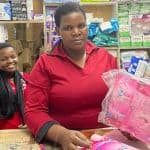Surveying the Landscape for Social Investments in Africa: A Major New Study Assesses the Current State of Play on the Continent
The social investment sector in Africa is dynamic and growing – but it’s struggling to close the enormous Sustainable Development Goals (SDG) financing gap.
The African Venture Philanthropy Alliance (AVPA) explored the opportunities and obstacles facing social investors on the continent in an ambitious new study, “The Landscape for Social Investments in Africa.” The report assesses the diverse field of social investment across East, West and Southern Africa, where hundreds of institutions – from foundations and corporations, to family offices, development finance institutions, governments and faith-based organizations – are working to provide much-needed capital.
NextBillion interviewed AVPA’s CEO, Frank Aswani, to discuss the study’s findings, and what they say about the current state of social investment in Africa. His insights provide a valuable snapshot of a sector in transition.
James Militzer: Why did AVPA decide to conduct this study: What gaps does it intend to fill in our understanding of social investment in the region?

Frank Aswani, CEO of the African Venture Philanthropy Alliance
Frank Aswani: Africa needs $500 billion – $1.2 trillion annually between now and 2030 in order to meet its SDG financing goals. Traditionally, this social financing would have come from aid, government funding, philanthropy and foreign direct investment. Aid followed by foreign direct investment are the biggest sources of social funding outside of governments. However, as more African countries move into middle income status, they become less deserving of aid – a crisis of success. This has led to declining aid to Africa that’s also been brought about by changing donor priorities, as many traditional aid agencies move from aid to impact investing. Our governments have also borrowed heavily over the last few years to fund infrastructure projects, as seen in the growing public debt-to-gross domestic product ratios across the continent. The COVID-19 pandemic has put even more pressure on the SDG financing gap, as governments rolled out emergency stimulus packages.
All of these factors have led to a dearth of capital in the traditional social development sector, highlighting the need for Africa to think differently about how to find capital for its social needs. Part of this shift has been to see how Africa can tap into the private sector for capital, where global financial and capital markets hold over $500 trillion. This will, however, require a paradigm shift – from funding to financing. Africa will need to also look at policy review, the development of new competencies by social investors, and the creation of new partnerships and collaborations by players in the social investment space across the continuum of capital – i.e., providers of grants, debt and equity – if Africa is to meet its SDG financing targets.
In terms of gaps, the study aimed to establish a baseline of Africa’s current state of play towards meeting our social investment financing challenges, and our readiness to embrace this new paradigm of collaboration between the private and development sector to mobilize sufficient capital to meet our social investment needs. It also assessed the broad adoption of innovative finance principles like blended finance, venture philanthropy and impact investing, just to mention a few. Finally, the study aimed to identify programmatic and research opportunities for interventions that could help Africa close its knowledge and competence gaps in social investing, so as to accelerate its own growth trajectory towards the 2030 SDG targets and beyond.
JM: Briefly describe the focuses of the report, and how you conducted it: Who did you speak to, and what were you trying to learn?
FA: We did the study between November 2019 and September 2020 in nine “deep dive” and nine “dipstick” countries equally spread across East, West and Southern Africa. That’s why we have three regional reports and a pan-African comparative report. Our research partner was Intellecap, and we used a combination of primary and secondary research to gather data on over 800 individuals and 150 organizations. As you can imagine, this process was negatively affected by the pandemic and, as a result, the study took longer than we’d imagined. The reports focused on mapping out players in the social investment space, including providers of debt, equity or grants – i.e., foundations (local and international), impact funds, aid agencies, foreign direct investment providers, governments and corporates – and also those offering non-financial capital, like business advisory services, monitoring and evaluation services and research organizations, among others.
The following were the research questions:
- Who are the active social investors across Africa, what capital are they deploying, how and with whom?
- What are the capital pools, investment strategies, innovative financing structures and partnerships?
- What is the concentration of capital across sectors, geographies and stages?
- How does supply of capital stack up against demand?
- How is the enabling environment for social investment?
- What are the recommendations for fostering social investment sector growth, increasing the flow of capital, effectively deploying capital and collaborating to achieve the SDGs?
The study produced regional and continental recommendations of programmatic interventions that the AVPA network (or any other players) could implement in order to close gaps, as well as areas that require additional research.
JM: What do you view as the three most important trends revealed in the study?
FA: The three most important trends revealed in the study are as follows:
- Social investment seeking maximum social impact is growing across the continent, with over 800 players identified across the three African regions – East, West and South. These are players deploying capital across the continuum of capital – grants, debt and equity – and seeking social impact with varying expectations of financial returns. However, the collaboration and innovative finance competence amongst these players is still not at the scale necessary to move the needle at the required speed.
- Social investment in Africa by capital volume remains dominated by bilateral donors and development finance institutions based largely outside of the continent. However, social investment activity is rising significantly amongst Africa-based corporates and foundations across the three regions. We need to see greater collaboration between local and international social investors.
- Aid to Africa is reducing. This is significant, especially when you consider that most of the funding to social investments in Africa comes in the form of aid. Hardest hit was Southern and East Africa, where aid reduced by 20% and 7% respectively between 2013 and This opens up great opportunities for innovative finance, leveraging catalytic grant capital to crowd in private sector capital for more sustainable social impact.
JM: What do you see as the key challenges to increasing capital flow to impact-focused enterprises in the region? Are any of these challenges unique to sub-Saharan Africa?
FA: The key challenges include:
- Lack of investor knowledge and competence in innovative finance leaving African social investors in their traditional silos of capital deployment – e.g.: foundations remaining as traditional grant-makers and not collaborating with other investors as providers of catalytic capital to unlock private capital.
- The small-scale nature of many African impact enterprises makes it harder to deploy capital to them.
- Lack of scalable mechanisms to support effective capital deployment into smaller ticket-size investments.
- Lack of appreciation of the SDG financing challenge facing the continent and the declining traditional sources of social investment capital, i.e.: aid and government funding.
- Outdated policies that don’t recognize the shift needed to enhance social investments in this new paradigm, where aid and government funding are under pressure and private-development sector collaboration should be encouraged.
- Lack of policies to deliberately support the small and medium enterprises (SMEs) and social sectors. We have, however, seen acts of parliament to benefit startups being adopted in Tunisia, Rwanda and Senegal, and social sector policies being drafted in Kenya and South Africa.
- Lack of platforms to make it easier for social investors seeking capital (grants, debt and equity), co-investors and pipelines to easily connect and collaborate.
- A general lack of the culture of syndicated deals and risk-sharing amongst African social investors.
- Lack of high-risk, early-stage capital to support the building of a solid early-stage pipeline.
- Lack of adequate, investor-ready deal flow of impact enterprises.
- Declining funding for nonprofits, which are struggling to diversify their revenue and establish more sustainable funding models. Many lack the know-how at the management and board level to make the transition from traditional grant recipients to other funding models.
- Inadequate connections between different investors so that the right funding can be tailored to the different stages of the enterprise growth cycle.
- A need for more knowledge and learning resources, for both the ecosystem that supports SMEs and the entrepreneurs themselves.
None of these challenges are unique to Africa, but they are more pronounced on the continent than in other regions. Furthermore they offer a much higher Impact return on investment should they be addressed through effective programs and interventions.
JM: What are some of the key opportunities that funders in the region seem to be overlooking?
FA: There are several overlooked opportunities, including:
- Investor education/capacity building in innovative finance. The African social investor needs a good understanding of innovative financing options (blended finance, impact investing, venture philanthropy, etc.) so that they can contribute effectively to addressing the social investment financing challenge on the continent. The current lack of know-how leaves many African social investors unable to not only mobilize capital effectively, but also to deploy it for maximum impact.
- Ecosystem building: Addressing the current challenges requires non-traditional alliances which would never happen on their own – e.g.: private sector/development sector collaboration. These can ideally be built through neutral ecosystem players like AVPA, who bring together these non-traditional players and showcase opportunities for impact to all concerned. Our knowledge of both sectors also helps in supporting the building of effective partnerships. More than ever before, we need to break down investor silos for greater social impact.
- Providing grant catalytic capital to de-risk social investments especially for smaller ticket-size investments, and to crowd private capital into social investments.
- Providing technical assistance (TA) funds to support impact-focused SMEs and entrepreneurs.
- Providing funding to improve the quality of accelerators and incubators, in order to increase the quality and quantity of investable deal flow across the continent.
- Investing in formal education-level entrepreneurship programs (high school and universities).
- Investing in supporting NGO’s diversify their resource mobilization strategies to reduce dependency on grants.
- Offering Non-financial support to Impact organizations – It’s not always about money.
- Gender lens investing: Effective gender-smart investing in Africa could unlock up to $316 billion – or 10% of GDP growth – between now and 2025.
JM: The report shows that “the majority of social investment capital deployed across these regions continues to come from international sources.” What needs to happen to bring local funding sources closer to the level of their international counterparts?
FA: The following measures are needed:
- Using some of this foreign funding for capacity building of African social investors, especially in innovative finance. This would range from supporting angel investors to foundations, impact funds, private equity/venture capital and corporates.
- Deliberate engagement between international and local investors, to not only increase collaborative co-investment, but also to better enable mutual understanding of each other’s challenges and mandates, and to encourage the transfer of effective practices.
- Specifically working with grant-makers on the continent to help them transition from traditional grant-making into catalytic investments – and in the process, unlocking and crowding private capital into social investments.
- Increasing the use of foreign funding as catalytic and technical assistance capital in Africa, so as to unlock local private capital.
- Offering support to ecosystems like AVPA that support African social investors, keeping the social investors connected and informed.
- Improving the policy space to enhance and encourage social investments – for example, crafting regulation to drive corporate sustainability and scale corporate social investment, which we have seen work well in countries like South Africa and India.
- Bringing public funding into the social investment space, by increasing collaboration between governments and other social investors. Governments are the biggest funders of social investments. Their funding could be used more productively if aligned to other investors and crowd in a lot more capital. This is especially important in key sectors like agriculture, health and energy, which are currently very donor dependent and at highest risk from the declining donor funding.
- Using platforms like AVPA’s Deal Share Platform (DSP) to increase collaboration and coinvestment amongst African social investors, and also between Africans and their international peers – while also learning from other regions. This will accelerate Africa’s progress and increase flow of capital into African social investments.
- Smartly tapping into pools of capital that are unique to Africa, like diaspora and faith-based capital for social investments.
JM: The report also calls for more innovation in funding approaches: What are some promising funding innovations you’ve seen, and how can these be scaled?
FA: Some promising innovations include:
- Blended finance approaches that leverage diverse social investors, capital and investment instruments: These are emerging as crucial tools in solving development challenges on the continent. Such approaches/structures include: Social and development impact bonds (SIB/DIBs) that leverage philanthropic, government and donor funds to pay for the outcomes of a specific project. Some notable SIB/DIBs on the continent include: The Green Outcomes Fund (energy), the Impact Bond Innovation Fund (education) and Bonds4Jobs (youth employment) in South Africa, and the Malaria Performance Bond (health) in Mozambique.
- Catalytic capital structures, in the form of grants, debt, equity, hybrid approaches and guarantees: These play a key role in seeding, scaling and sustaining social enterprises. Structures such as the Catalytic Capital Consortium launched by the MacArthur Foundation, in partnership with the Omidyar Network and the Rockefeller Foundation, seek to mobilize catalytic capital from diverse social investors and effectively deploy these across projects and enterprises. We would like to see African-seeded catalytic capital consortia emerging in the very near future, as these would unlock plenty of local capital.
- Crowdfunding: Online crowdfunding platforms are increasingly being used to raise both donations and commercial capital from individuals and institutions, both locally and internationally. Such platforms are particularly being leveraged by social enterprises, as well as NGOs operating in the region.
Key considerations for creating successful structures that can be replicated and scaled across sectors and geographies include: ensuring a good balance of priorities for the development and commercial actors involved; calibrating the risk-return expectation for commercial investors in order to attract sufficient capital; providing investor education on innovative finance; developing case studies and benchmarks for others to learn from, building local institutional capacity on Innovative Finance and promoting continuous multi-stakeholder engagement in order to understand context, mitigate risk, drive impact and generate stronger social and financial returns.
JM: The study notes that across the region, tech-based enterprises in multiple sectors have received the highest focus from social investors. Do you see this primarily as a positive trend, or a troubling one? Is investors’ traditional desire to find (and profit from) the next breakthrough tech enterprise resulting in the exclusion of less flashy, but perhaps more impactful businesses?
FA: There is a lot of social good that the tech sector has accomplished and will continue to do across the continent. That said, we would certainly like to see the reach and impact of social investment diversify beyond major sectors and large markets. Rural communities, smaller economies and sectors not necessarily driven by tech all require investment if Africa is to achieve the SDGs for all citizens. Where those investments may be less profitable is where we need to seek solutions in policy innovation and innovative finance that efficiently blends philanthropic and commercial capital.
JM: What are the key areas where additional future research is needed, to build upon these findings? And do you intend to repeat this study in the coming years?
FA: The AVPA landscape study is a baseline study, and our hope and plan is to repeat this study every 2-3 years to track the progress and adoption of innovative practices that help increase the flow of capital into African social investments, and ensure that this capital is deployed for maximum impact through the application of innovative finance principles.
Key areas for future research include:
- The sectoral performance of blended and catalytic financing structures.
- The usage of blended and innovative finance for smaller transactions.
- Benchmarking analysis of corporate social investment policies to provide best practices to guide policy formulation.
- Effective ways to engage the diaspora to raise and structure development finance at scale.
- Identifying strategic collaboration mechanisms through which social investors can engage with faith-based giving (as Africans are big givers to their religious groups).
- Frequent data gathering, e.g.: through annual surveys to generate quantitative data for foundations and corporate social investors headquartered in the region.
- Understanding the effectiveness of different technical assistance models adopted by investors across sectors.
- Producing case studies of successful models adopted by grant-makers transitioning into impact investing and venture philanthropy.
- Demand-side research – i.e.: engaging with social enterprises and NGOs to better understand their changing needs.
- Impact of the Africa free trade agreement (AfCFTA) on social impact, especially scaling proven solutions. What revisions, policy or otherwise, do we need to implement to take advantage of this agreement?
We hope that social investors can leverage the study to identify programmatic interventions and research opportunities so that when the study is repeated in 2-3 years, we’d have made progress from our current baseline, mobilized more capital, deployed it with greater impact and moved Africa closer to the 2030 SDG targets. The AVPA network is very keen to support and collaborate with social investors interested in investing in Africa, so as to help them increase their impact on the continent. We are uniquely positioned to do this due to our broad constituency of partners, consisting of players deploying debt, equity and grants. And being part of an international network of sister organizations, including EVPA in Europe, AVPN in Asia and Latimpacto in Latin America, enables us to effectively and seamlessly connect international social investors to their African peers – and also to move learnings at speed from and to other regions, especially similar economies in the global South (Asia and Latin America).
For more information, please contact Frank Aswani at Faswani@avpa.africa.
James Militzer is the managing editor at NextBillion.
- Categories
- Impact Assessment, Investing, Social Enterprise



